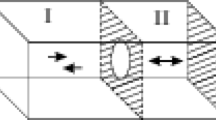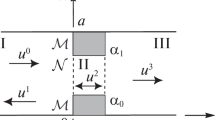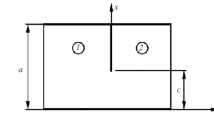Abstract
A rectangular resonator with holes embedded in two plane-transverse resonant diaphragms is built in a plane infinite waveguide. The problem of diffraction of the intrinsic wave of a waveguide incident on the diaphragm (hole in the wall of the resonator) is solved. The paired series functional equations of the diffraction problem, by the method of integral-adder identities, are reduced to an infinite set of linear algebraic equations, which is solved by the truncation method. The initial diffraction problem is studied from the point of view of the resonant passage of the wave through the resonator region. A computational experiment has shown that partial or complete passage of a wave through a resonator with holes is observed only at frequencies close to the eigen frequencies of the resonator without holes, while the holes in the resonator walls (diaphragm parameters) significantly affect the scattering matrix of this waveguide structure.
Similar content being viewed by others
Avoid common mistakes on your manuscript.
1 INTRODUCTION
Waveguides are widely used in the physics of microwave oscillations [1]. As it is known, plane-transverse inhomogeneities are often used in waveguide technique to form resonators and matching elements. The most popular among them are thin metal diaphragms, which are placed perpendicular to the longitudinal axis of the waveguide and partially overlap its cross section.
The problems of diffraction of electromagnetic waves by diaphragms and other inhomogeneities are considered in the lecture notes of Yu. Schwinger [2].
Waveguides with resonant structures and other inhomogeneities are used as mode converters or as filters. An analysis of the waveguide bandpass filter on complex resonant diaphragms with L-shaped ridges is given in [3, 4]. The possibility of using a waveguide filter with resonant diaphragms for the irradiator of mirror antennas is shown in [5].
In this work, we study the two-dimensional diffraction problem of a TE–wave in an infinite diaphragmed waveguide with a built-in rectangular resonator (Fig. 1). The resonator in the waveguide corresponds to region II between two sequentially arranged parallel diaphragms. Some resonance properties of a rectangular resonator with a hole in the wall, by means of a computational experiment, were established in [6], where it was shown that the resonance frequencies of a straight-line resonator with a small hole in the wall are close to the natural frequencies of the same resonator but without a hole.
In this paper, we will use the method of integral-series identity [7] when reducing paired series functional equations on diaphragms to a regular infinite system of linear algebraic equations (ISLAE).
We will study the diffraction problem from the point of view of the resonant propagation of a wave through region II. Besides the monograph [8], in which many specific examples of problems with resonant scattering are given, we note [9], where the problem of the resonant transmission of the main wave of a rectangular waveguide through a diaphragm is studied. We also note the well-known effect of resonant reflection of the main wave from the abrupt expansion of the waveguide [10].
2 THE TWO-DIMENSIONAL DIFFRACTION PROBLEM IN AN INFINITE DIAPHRAGMED WAVEGUIDE
Let us consider the two-dimensional diffraction problem of a TE-polarized wave in an infinite plane waveguide with a built-in rectangular resonator with holes (Fig. 2). Let \(a\) be the cross-sectional size of the waveguide. The resonator corresponds to the region \(0<x<a\), \(0<z<c\) between two resonant diaphragms located in the planes \(z=0\), \(z=c\) the cross section of the waveguide. We denote by \(\mathcal{N}_{0}=(\alpha_{0},\beta_{0})\) the hole of the diaphragm located in the plane \(z=0\), and by \(\mathcal{M}\) its remaining part. Similar notation, but with the index \(c\), will be used for the second diaphragm located in the plane \(z=c\). Thus, all the parameters of the waveguide structure can be set by the sizes of the resonator \(a,c\) and its holes in the walls \(\mathcal{N}_{0}=(\alpha_{0},\beta_{0}),\mathcal{N}_{c}=(\alpha_{c},\beta_{c})\).
Suppose that there are no free currents and charges, the medium is homogeneous and isotropic, the electromagnetic field is harmonically dependent on time, and this dependence has the form \(e^{-i\omega t}\) and does not depend on the coordinate \(y\). The potential functions of TE polarized eigenwaves have the form
moreover \(Re\gamma_{n}>0\) or \(Im\gamma_{n}>0\). The sign \(+\) corresponds to waves of positive orientation (propagating to the right or decaying to the right) and the sign—corresponds to waves of negative orientation (propagating to the left or decaying to the left). The wave number \(\kappa\) is directly proportional to the frequency of electromagnetic waves.
Let eigne wave \(u^{0}(x,z)=\varphi_{l}(x)e^{i\gamma_{l}z}\) run on the diaphragm in the plane \(z=0\) out of the waveguide. We will look the reflected wave (\(z<0\)) in the form \(u^{1}(x,z)=\sum_{n=1}^{+\infty}a_{n}\varphi_{n}(x)e^{-i\gamma_{n}z},\) standing wave (\(0<z<c\)) and refracted wave (\(z>c\)) in the form
respectively. We write down the boundary conditions and the conjugation conditions for \(z=0\). On the metal \(\mathcal{M}_{0}=\{0<x<\alpha_{0}\}\cup\{\beta_{0}<x<a\}\) we have
and on the hole \(\mathcal{N}_{0}=\{\alpha_{0}<x<\beta_{0}\}\) we have
Now we write down the boundary conditions and the conjugation conditions on the second diaphragm (\(z=c\)). On metal \(\mathcal{M}_{c}=\{0<x<\alpha_{c}\}\cup\{\beta_{c}<x<a\}\) we have
and at the hole \(\mathcal{N}_{c}=\{\alpha_{c}<x<\beta_{c}\}\) we have
We denote
Theorem 1. The problem of the electromagnetic wave diffraction on diaphragm (hole in the wall of the resonator) is reduced to ISLAE
relative to the coefficients \(b_{n}\), \(c_{n}\) of the standing wave \(u^{2}(x,z)\).
Note that the ISLAE (9), (10) should be solved together relative to the vector \(\left(b_{1},b_{2},\dots,c_{1},c_{2},\dots\right)\).
Proof. From (1), (2) and (3) follows that (3) is fulfilled on \(\mathcal{N}_{0}\) and on \(\mathcal{M}_{0}\). Then \(a_{l}=\left(b_{l}+c_{l}\right)-1,\) \(a_{n}=\left(b_{n}+c_{n}\right),\) \(n\not=l.\) We exclude the variables \(a_{n}\) from (4) and get on \(\mathcal{N}_{0}\)
To regularize paired series functional equations (2), (11), we use the integral-series identity (ISI)
where \(K(x,t)=\sum_{m=1}^{+\infty}\frac{1}{\gamma_{m}}\varphi_{m}(x)\varphi_{m}(t).\) We have from the ISI by (11) on \(\mathcal{N}_{c}\)
Project pair equation (2) and (12) on functions \(\varphi_{k}(x)\). The result will be (9).
Now we consider the boundary and conjugation conditions for \(z=c\) (on the second diaphragm). From (5), (6) and (7) it follows that (7) is fulfilled both on \(\mathcal{N}_{c}\) and on \(\mathcal{M}_{c}\), then \(d_{n}e^{i\gamma_{n}c}=(b_{n}e^{i\gamma_{n}c}+c_{n}e^{-i\gamma_{n}c}).\) We exclude \(d_{n}\) from (8) and get on \(\mathcal{N}_{c}\)
ISI takes place
We have from the ISI by (13) on \(\mathcal{N}_{c}\)
Project pair equation (6) and (14) on functions \(\varphi_{k}(x)\). The result will be (10). \(\Box\)
3 COMPUTATIONAL EXPERIMENT
An approximate solution of the ISLAE (9)–(10) will be sought by the truncation method. We write down truncated set of linear algebraic equations (SLAE)
Note that the SLAE (15)–(16) has a block structure of the form
where square blocks of size \(N\times N\) are denoted by capital letters and small are vectors of size \(N\). As numerical experiments show, for the internal convergence of the truncation method, it is sufficient to restrict ourselves to the case when \(N=M=20\). Note that the matrix of the system (17) has dimension \(2N\times 2N=40\times 40\).
We set the resonator sizes \(a=1.1\), \(c=2.2\) in dimensionless quantities. The calculation results have shown that the dependencies on the coefficients of the reflected (in region I) and transmitted (in region III) waves in the spectral parameters \(\kappa\) have resonances at frequencies close to the eigen frequencies \(\kappa_{m,n}\) of the resonator without holes. Moreover, the hole parameters \(\mathcal{N}_{0}=(\alpha_{0},\beta_{0})\), \(\mathcal{N}_{c}=(\alpha_{c},\beta_{c})\) affect the \(S\)-scattering matrix.
Fig. 3 shows the dependencies of the parameters \(S_{11}\) (solid line) and \(S_{21}\) (dashed line) of the \(S\)-scattering matrix of the spectral parameter \(\kappa\), which varies within the eigne frequency \(\kappa_{1,1}\approx 3.1931\). The holes are chosen as follows: \(\mathcal{N}_{0}=\mathcal{N}_{c}=(0.4,0.7)\).
4 CONCLUSION
The diffraction problem of a TE-wave in a plane waveguide with an integrated resonator is reduced to an infinite set of linear algebraic equations for the field expansion coefficients in the resonator region.
Computational experiments have shown that the dependencies of the modules of the coefficients of the reflected and transmitted (in region III) waves are resonant in nature. Resonances are observed at incident wave frequencies close to the eigenfrequencies of the resonator without holes. Thus, it can be concluded that near the eigen frequencies of the resonator, partial or complete passage of the incident wave is possible, while the parameters of the holes in the resonator walls significantly affect the \(S\)-scattering matrix of this waveguide structure.
REFERENCES
F. E. Borgnis and C. H. Papas, ‘‘Electromagnetic waveguides and resonators,’’ Handbuch. Phys. 16, 285–422 (1958).
Yu. Schwinger, ‘‘Inhomogeneities in waveguides (lecture notes),’’ Zarub. Elektron., No. 3, 3–106 (1970).
V. V. Zemlyakov, G. F. Zargano, and S. V. Krutiev, ‘‘Waveguide bandpass filter on complex resonance diaphragms,’’ Radiotekh. Elektron. 60 (12), 105–116 (1968).
V. V. Zemlyakov and G. F. Zargano, ‘‘Electrodynamic analysis of conductivity of a resonance waveguide plane-transverse diaphragm with a complex aperture,’’ Radiophys. Quantum Electron. 58, 504–510 (2015).
Y. V. Krylov and A. Y. Lapin, ‘‘Broadband waveguide filter of feed reflector antennas,’’ Reshetnev. Chten.1, 132–134 (2016).
G. V. Abgaryan and N. B. Pleshchinskii, ‘‘On the eigen frequencies of rectangular resonator with a hole in the wall,’’ Lobachevskii J. Math. 40 (10), 1631–1639 (2019).
N. B. Pleshchinskii, Models and Methods of Waveguide Electrodynamics (Kazan. Univ., Kazan, 2008) [in Russian].
V. P. Shestopalov, A. A. Kirilenko, and L. A. Rud,Resonance Scattering of Waves, Vol. 2: Waveguides Heterogeneity (Naukova Dumka, Kiev, 1986) [in Russian].
N. G. Don, A. A. Kirilenko, and S. L. Senkevich, ‘‘A new type of natural oscillations and the resonance of the full passage through the diaphragm with a transverse hole in a rectangular waveguide,’’ Radiophys. Quantum Electron. 52, 101 (2008).
E. T. Jaynes, ‘‘Ghost modes in imperfect waveguides,’’ Proc. IRE 46, 416–418 (1958).
ACKNOWLEDGMENTS
The work is performed according to the Russian Government Program of Competitive Growth of Kazan Federal University.
Author information
Authors and Affiliations
Corresponding author
Rights and permissions
About this article
Cite this article
Abgaryan, G.V. On the Resonant Passage of Electromagnetic Wave through Waveguide with Diaphragms. Lobachevskii J Math 41, 1315–1319 (2020). https://doi.org/10.1134/S1995080220070021
Received:
Revised:
Accepted:
Published:
Issue Date:
DOI: https://doi.org/10.1134/S1995080220070021







